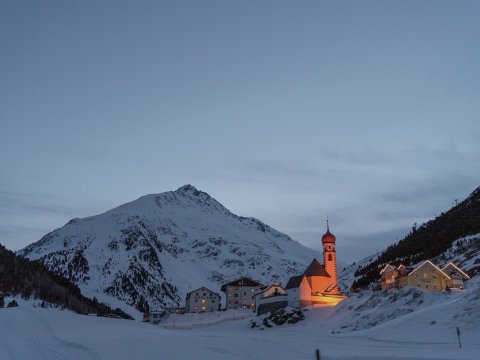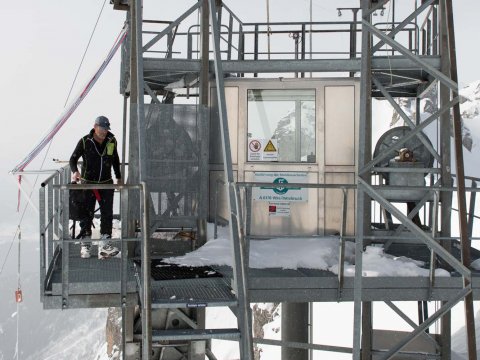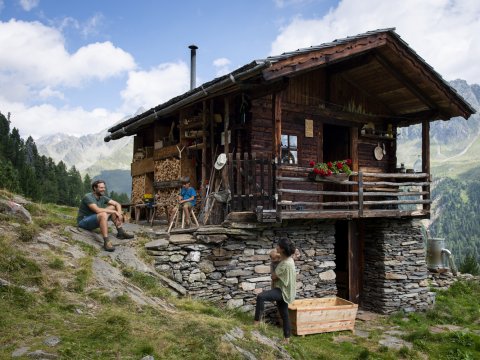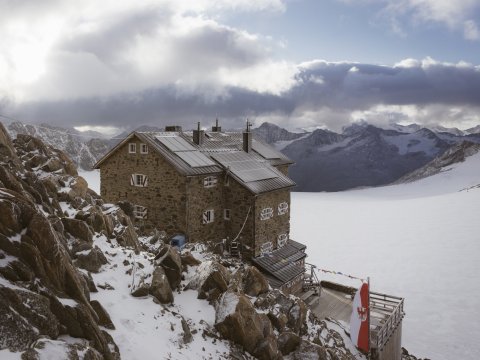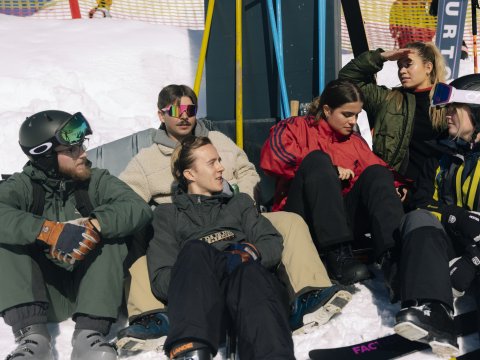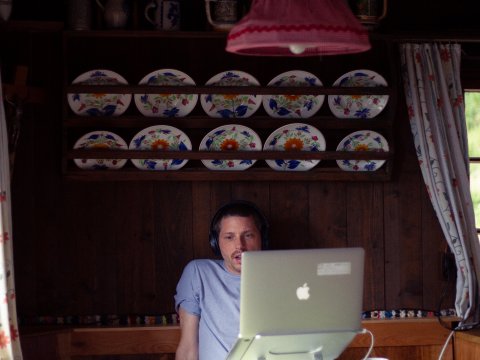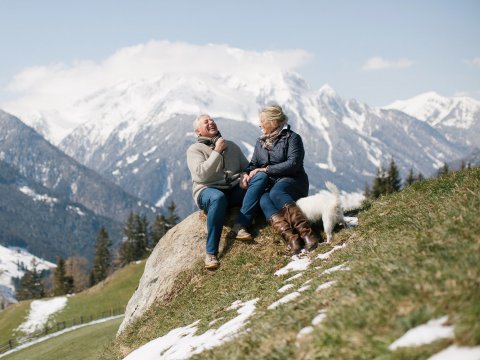Alpine Mountain Gold

Interview: Tristan Berger, Photographs: Sebastian Gabriel
Does the taste of honey change when the bees are not buzzing in the valley but high up in the alpine mountains? Reinhard Hetzenauer, chairman of the Tirolean Beekeepers Association, tells us more about the life of bees at 1,500 metres above sea level and the unique taste of alpine rose honey.
Albert Einstein is thought to have said: “If the bee disappeared off the face of the Earth, man would only have four years left to live.” Is this true?
I’m not sure whether it was Einstein who said that. However, if there were no more bees, many plants would not be pollinated and would become extinct. As a result, many birds would not exist anymore and so on – and in the end this would also affect us as humans. Nature would still exist; however, it would look completely different, and I would not want to take that chance.

Many people are concerned about the death of bees. So, how are the bees doing?
As long as there are beekeepers, there will always be honey bees, and they will not become extinct. The good news is that the number of beekeepers in Tirol has increased by a third since 2009 – so at least the honey bees are in good hands. Some biologists even say that there are too many honey bees and that they are taking away honey from the wild bees.
Is that true?
That may apply in some areas. Some wild bees prefer certain blossoms and that can lead to competition between the bees. Many beekeepers also take care of the wild bees by building beehive hotels for them.
And you also set up your beehives in the alpine mountains, don’t you?
I have one location in the Axamer Lizum and another one at the Kemater Alm at about 1,600 metres above sea level. My other five locations are all in the Inntal valley.

Do the bees enjoy being in the Alps?
This is a beautiful place for the bees, and they can enjoy the marvellous views – it’s like being on holiday. I’m not kidding. Here in the alpine mountains the honey flow season lasts longer than in the Inntal valley. Honey flow is what beekeepers call the supply or period of availability of nectar, pollen, and honey dew suitable for bees to convert into honey. In the valley, the honey flow decreases drastically when the meadows are cut. Then again, there are higher risks in the alpine mountains. The weather can change suddenly. Then there’s not enough honey flow and the bees have to live off the sugar water I feed them. Logically, that also means no more honey.
How did you become a beekeeper?
My grandfather had two bee colonies which I took over when I was searching for an activity to unwind from a stressful job. That was thirty years ago. It’s such a joy working in and for nature – here in the outdoors you can witness what is blossoming. The only exhausting part of the job is the honey harvesting. Especially the spinning part, when the honey combs are spun in a centrifugal honey extractor. That’s the part I enjoy the least, because you have to be so careful and make sure nothing sticks together.
How many bees have you got in total?
At the moment I have 45 bee colonies, each consisting of a queen bee, drone bees, and worker bees. One colony comprises 60,000 bees during the summer but only 10,000 during the winter.

Are there any differences between the alpine bees and the bees in the valley?
I keep the Carinthian Bee or “Carnica” in the valley as well as in the mountains. The alpine bees, however, seem more resilient than the bees in the valley. They even still fly out when it cools down to eight degrees Celsius. Beyond that, the Carnica is more docile and forms larger colonies than the Dark European Honey Bee originally native to Tirol. This means more honey!
How much honey do you get from one colony?
On average around 15 kg. The beekeepers in eastern Austria often make fun of us alpine beekeepers because they produce around 80 kg per colony. In total, I produce around 600 kg per year, sometimes it can amount to 1,000 kg. In Tirol, the agriculture is structured differently and divided into smaller parts. There are no monocultures like in eastern Austria, so there is a restricted availability of nectar, pollen, and honey dew. The weather also plays a crucial role here in the Alps. The honey yield can fluctuate between zero and 30 kg per colony. All the 3,000 Tirolean beekeepers together produce no more than 300 tonnes per year.
What does the alpine honey taste like?
There are no rape or sunflower fields in Tirol, so the bees have to head for different blossoms. In the Inntal valley there is a larger selection of blossoms: flower fields, fruit trees, forests. That’s why our honey is more diverse and richer in variety than the honey from eastern Austria. If there is an abundant amount of a certain plant genus, this clearly dominates the taste of the honey. If the bees fly into the forest a lot because I have placed the beehives at the edge of the woods, this leads to a darker wild honey with a more intensive taste. If the pastures are full of alpine roses, the honey has a unique taste of alpine roses.
How do you know when the honey is ready to be harvested?
As soon as one third of the cells are sealed, the honey is ripe.

So that means that honey has to ripen?
The bees collect nectar and when transporting the nectar to the beehive, acids, enzymes, and other proteins are transferred from the bee to the nectar, converting the nectar into honey. Moreover, the bee extracts water from the nectar in several steps. The honey is ripe as soon as it contains less than 20 per cent water.

Do the bees still often sting you when you’re harvesting the honey?
Each and every time when I visit the bees – that’s normal, but it’s still always painful. The spot where you have been stung starts to swell and there’s this warm feeling in your body. The bee venom prompts the body to produce cortisol. So, despite the discomfort felt, bee stings can actually promote health. But remember that too much of anything is unhealthy! By the way, when there is a foehn wind the bees get annoyed and moody. It gets even worse when there is a thundery atmosphere. That’s when they turn “fidgety”. In the mornings they are often still quite sleepy though.
How do you know how the bees are feeling?
The bees don’t whine, they can’t tell me what they are thinking or feeling. I have to interpret their behaviour. I observe the bees and how they behave at the hive entrance. If they fly into the hive laden with pollen and subsequently leave the hive again, all is well. However, if they seem to be wobbling about, there is imminent danger.
What could that kind of behaviour indicate?
That’s something I then have to take a closer look at. The biggest problem is the Varroa mite which jumped species from the Eastern Asian Honey Bee to our honey bee. Climate change has fostered the spread of this mite. It’s a parasite which feeds off the bee’s blood in winter, and in summer it sneaks into the developing brood and reproduces. Typically, the queen bee does not lay eggs when it’s cold. However, due to global warming, there is no brood-free time anymore. So, the mite can also reproduce all year round.

So, what are you doing to fight this?
A natural method is formic acid. The aroma would, however, affect the taste of the honey, so I wait until I have finished harvesting the last bit of honey – at the beginning of August – and then treat the colonies with this formic acid. The next honey is then produced the following spring.
Do you recommend beekeeping as a hobby?
You have to be able to unwind and have a calm energy because the bees don’t like hectic atmospheres. Beekeepers must be considerate and aware that they are dealing with ladies. You cannot just set up a beehive in your garden and think that you can simply pick up your honey in autumn. Beekeeping requires expertise and time. My wife always says: “You’ve always got time for the bees and are always there for them whenever they need you. When I need something, I have to wait for ages.”









